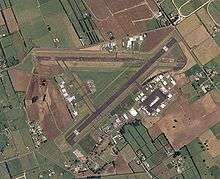Ardmore Airport (New Zealand)
| Ardmore Airport | |||||||||||||||||||
|---|---|---|---|---|---|---|---|---|---|---|---|---|---|---|---|---|---|---|---|
 | |||||||||||||||||||
| Summary | |||||||||||||||||||
| Airport type | Public | ||||||||||||||||||
| Owner | Ardmore Airport Ltd | ||||||||||||||||||
| Operator | New Zealand Civil Aviation Authority | ||||||||||||||||||
| Location | Auckland | ||||||||||||||||||
| Elevation AMSL | 111 ft / 34 m | ||||||||||||||||||
| Coordinates | 37°01′47″S 174°58′24″E / 37.02972°S 174.97333°E | ||||||||||||||||||
| Runways | |||||||||||||||||||
| |||||||||||||||||||
Ardmore Airport (IATA: AMZ, ICAO: NZAR) is an airport 3 NM (5.5 km) southeast of Manurewa in Auckland, New Zealand.
History
Ardmore was constructed during World War II by USAAF forces stationed in Auckland, and was intended to be used as a base for B-17 Flying Fortress bombers. Due to developments in the Pacific War it was never used for this purpose; but was instead was used by the RNZAF, who operated Corsair fighters. RNZAF Auckland operations were consolidated at Whenuapai after the end of World War II. From the post-war years until the mid-1970s the grounds were home to a teacher training unit and the Auckland University School of Engineering.
New Zealand Grand Prix
From 1954 until 1962 the aerodrome was home to the New Zealand Grand Prix with the circuit being approximately 2 miles (3.2 km) in length and utilising the two sealed runways operational at the time. In 1954 and 1955, about 70,000 spectators attended the event. Local authorities made the decision to open up the facility to general aviation and so the Grand Prix was moved to Pukekohe upon completion of a purpose built facility there.[1] British racing driver Ken Wharton was killed at the NZ Grand Prix at Ardmore on 12 January 1957, when he crashed his Ferrari Monza.
Present day
Ardmore Airport is one of New Zealand's busiest general aviation airfields. Traffic mainly consists of small private aircraft and the classic aircraft of the New Zealand Warbirds Association, which is based there. Businesses in the airfield include several flying schools, maintenance, fuel and aircraft restoration. Buildings are situated around Aprons to the North, West, South, and Southeast. A control tower remains in the center of the field, but this is no longer used for air traffic control. It is now used as a UNICOM service.
Operational information
Ardmore has six vectors 03/21 sealed runway, 03/21 grass runway and 07/25 grass runway. There used to be a 07/25 sealed runway however this is no longer used and is now a taxiway (Taxiway Juliet).
The airfield has a circuit height of 1,100 ft (340 m) for fixed-wing aircraft, 800 ft (240 m) for helicopters. The circuit for runway 03/07 is right hand while that of runway 21/25 is a left hand circuit.
The airfield is serviced by two R-NAV (GPS) arrivals, one for each runway (03 and 21). The airport itself is uncontrolled and located within a Mandatory Broadcast Zone (MBZ). This airspace is monitored by the Ardmore Unicom service who operate during daylight hours. The aerodrome is located to the south east of Auckland International Airport airspace.[2]
Airlines and destinations
| Airlines | Destinations |
|---|---|
| Flight Hauraki | Claris, Okiwi, Rotorua, Waiheke [3] |
| FlyStark | Claris, Whitianga |
| Sunair | Claris, Whitianga [4] |
Accidents and incidents
Accidents and incidents that occurred at or near Ardmore Airport include:
- 21 November 1944 - A Corsair based at Ardmore attempted a forced landing and crashed 1/2 a mile from the aerodrome. Fg Off D.G.A. Ritchie later died of injuries.[5][6]
- 6 March 1945 - A Corsair turned onto its back while coming in to land. Flt Sgt J.W. Wright was injured.[7]
- 3 December 2009 - A restored Spitfire tipped onto its nose while landing, damaging the propeller and undercarriage.[8]
- 27 September 2010 - A helicopter with two people on board was reported (by TV3 News) to have crashed. The aircraft reported a technical problem. A witness said the helicopter circled the aerodrome using up fuel and then the engine was cut and it glided in to land safely.[9]
- 4 January 2014 - A light aircraft, ZK-JEK, landed, vacated the runway before catching fire. Both occupants escaped without injury.[10][11]
- 6 March 2014 - A light twin Beechcraft Duchess suffered an undercarriage failure on the runway at Ardmore.[12]
- 29 June 2014 - A light aircraft, Cessna 152, had to make an emergency landing in a field approx. 3NM East of the airfield. The aircraft made a successful landing in the field before flipping upside down.[13]
- 28 September 2016 - A T-28 Trojan successfully made a belly Landing after its landing gear failed. [14]
See also
References
- ↑ Mackay,Ross. Racing: A history of motorsport in New Zealand.Whitcoulls 2007. ISBN 978-1-877327-45-2
- ↑ "New Zealand Aeronautical Information Publication". Retrieved 6 May 2013.
- ↑ "Island Hopper Service". Flight Hauraki. Retrieved 24 June 2015.
- ↑ http://sunair.co.nz/great-barrier-island-info Sunair - Great Barrier Island Airport Information
- ↑ "Blazing Plane | Evening Post". Fairfax Media (Wellington). 11 January 1945.
- ↑ "Pilot Injured | Evening Post". Fairfax Media (Wellington). 22 November 1944.
- ↑ "Pilot seriously injured | Evening Post". Fairfax Media (Wellington). 7 March 1945.
- ↑ "Multi-million dollar spitfire crashes | The New Zealand Herald". APN New Zealand Ltd. 3 December 2009. Retrieved 30 August 2011.
- ↑ "Emergency at Ardmore Airport". Retrieved 27 September 2010.
- ↑ http://tvnz.co.nz/national-news/plane-catches-fire-after-landing-ardmore-airport-video-5791114
- ↑ https://www.youtube.com/watch?v=_1QB4q7fePw
- ↑ http://tvnz.co.nz/national-news/light-plane-crashes-ardmore-airport-5859395
- ↑ Ryan, S. (29 June 2014). "Light plane crashes near Ardmore Airfield". APN New Zealand Ltd.
- ↑ "Light aircraft making emergency landing at Ardmore Airport". New Zealand Herald. NZ Herald. NZ Herald. 28-09-16. Retrieved 30-09-16. Check date values in:
|access-date=, |date=(help)